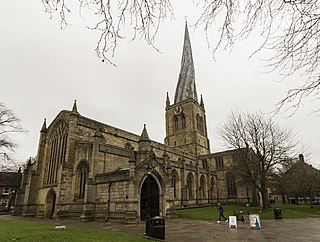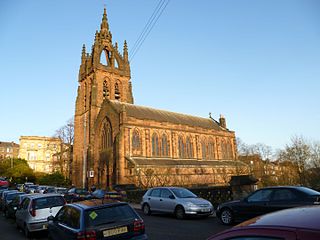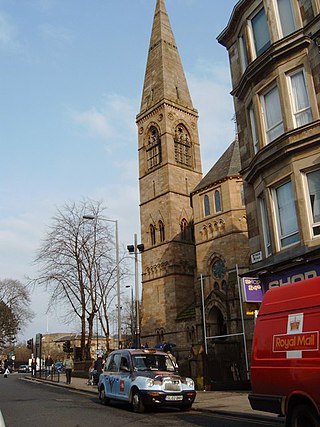
North Kelvinside is a residential district of the Scottish city of Glasgow.

Queen's Cross Church is a former Church of Scotland parish church in Glasgow, Scotland. It is the only church designed by Charles Rennie Mackintosh to have been built; hence, it is also known as The Mackintosh Church.
John James StevensonFRSE FSA FRIBA, usually referred to as J. J. Stevenson, was a British architect of the late-Victorian era. Born in Glasgow, he worked in Glasgow, Edinburgh and London. He is particularly associated with the British Queen Anne revival style.

Chesterfield Parish Church is an Anglican church dedicated to Saint Mary and All Saints, in Chesterfield, Derbyshire, England. Building of the church began in 1234 AD, though the present church dates predominantly from the 14th century. Designated a Grade I listed building in 1971, St Mary's is best known for its twisted and leaning spire. It is the largest parish church in the Diocese of Derby, and forms part of the Archdeaconry of Chesterfield. In 1994, it also became the UK's only representative in the Association of the Twisted Spires of Europe; of the 72 member churches, it is deemed to have the greatest lean and twist.

Kelvinbridge Parish Church, also known as the Kelvin Stevenson Memorial Church, is a Church of Scotland parish church, serving part of the North Kelvinside area of Glasgow, Scotland. The church is within the Church of Scotland's Presbytery of Glasgow.

A crown steeple, or crown spire, is a traditional form of church steeple in which curved stone flying buttresses form the open shape of a rounded crown. Crown spires first appeared in the Late Gothic church architecture in England and Scotland during the Late Middle Ages, continued to be built through the 17th century and reappeared in the late 18th century as part of the Gothic Revival.

St Mary's Church in Chute Forest, Wiltshire, England, was built between 1870 and 1871 and consecrated in 1875. It is recorded in the National Heritage List for England as a designated Grade II* listed building, and is now a redundant church in the care of the Churches Conservation Trust. It was declared redundant on 23 August 1972, and was vested in the Trust on 26 March 1974.

Margaret Isobel Chilton (1875–1963), born at Clifton, Bristol, was a British stained glass artist and instructor.
Herbert Hendrie was an English stained glass artist. He is known for his strong simple designs with scintillating jewel-like effects. Among his best-known works are the fifteen windows for Kippen church and the tall stained glass windows for Liverpool Cathedral.

St John's Church, formerly Dunoon Free Church, is a Presbyterian church building in Dunoon, Argyll and Bute, Scotland. A Category A listed structure, it is located in the town centre at the junction between Hanover Street and Victoria Road. The church is still in daily use.

St Andrews Anglican Church is a heritage-listed churchyard at 160 Vulture Street, South Brisbane, City of Brisbane, Queensland, Australia. It was designed by Andrea Stombuco and built from 1878 to 1932. It was added to the Queensland Heritage Register on 21 October 1992.

St Margaret's Church is a Category B listed church of the Scottish Episcopal Church at 355 Kilmarnock Road, Newlands, Glasgow, Scotland.
Stephen Adam (1848–1910) was a 19th/20th-century Scottish influential stained glass designer. He was a pioneer of modern stained glass in Scotland. The majority of his work is in the Pre-Raphaelite style, often with a twist towards Celtic mythology, and is mainly sited in western Scotland. Although the bulk of his work is for churches he also received many secular commissions.

Òran Mór is a theatre, restaurant, entertainment and music venue in Glasgow. From 1862 until 1978 the building was the Kelvinside Parish Church before becoming redundant and then converted into an entertainment venue in 2004.

Hyndland Parish Church also known as The Kingsborough Sanctuary, is a 19th-century church located in the Hyndland area of Glasgow.

Queen's Park Govanhill Parish Church is a 19th-century Parish church of the Church of Scotland located in the south side of Glasgow, near Queen's Park, from which the church's name derives.

Cottiers is a theatre located in Glasgow, Scotland. It also operates as a bar and restaurant. Cottiers occupies the building of the 19th-century former Dowanhill Parish Church.

Broomhill Parish Church, nowadays known as Broomhill Hyndland Parish Church, is a 20th-century church building located in the Broomhill area of Glasgow, Scotland.

Shettleston New Church is an early 20th-century church building of the Church of Scotland in the Shettleston district of Glasgow, Scotland.
Alfred Alexander Webster (1883-1915) was a Scottish stained glass artist in the early nineteenth century. His talent established him as the successor to the Glasgow stained glass designer Stephen Adam who in turn considered Daniel Cottier to be his master. Webster was considered one of the most accomplished artists working in stained-glass during this period. Websters Theatre, Glasgow on 416 Great Western Road, Glasgow is named after Webster as the building contains two major stained glass windows designed by him.


















